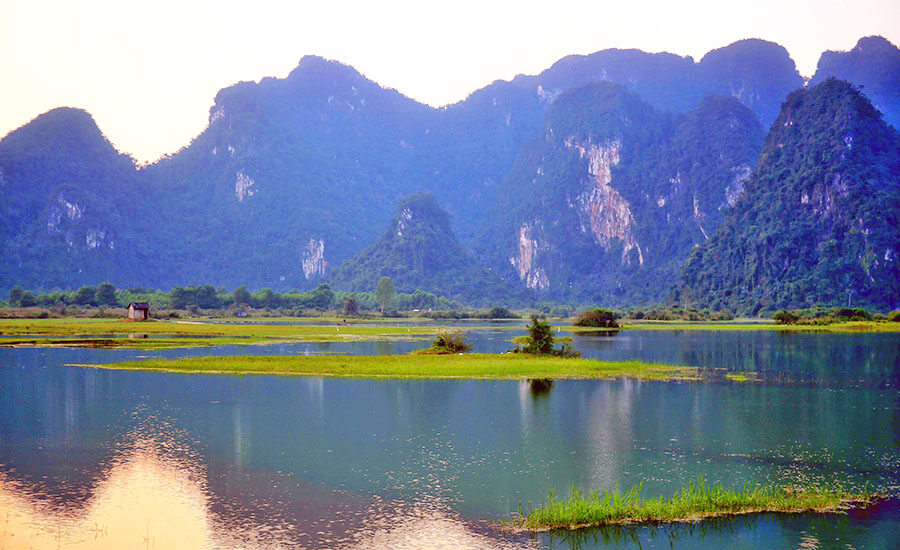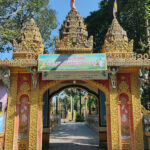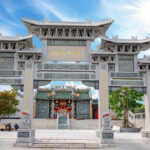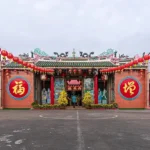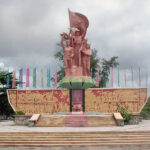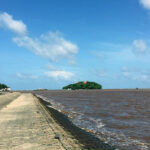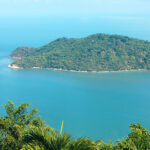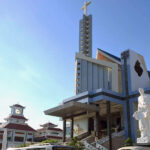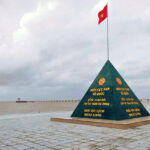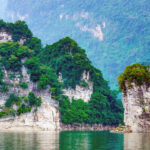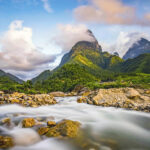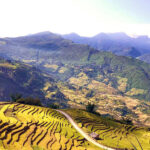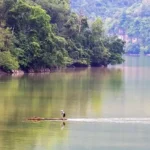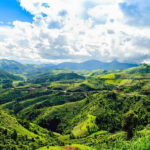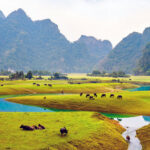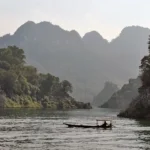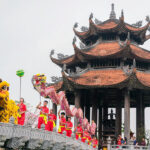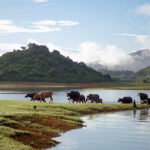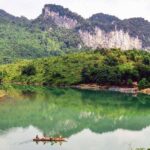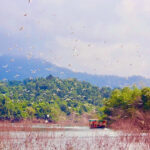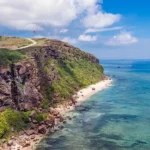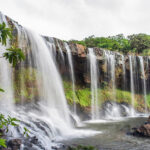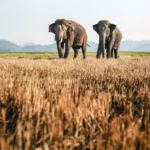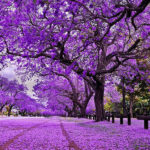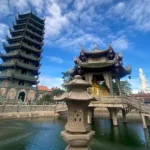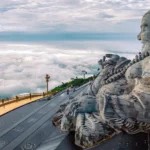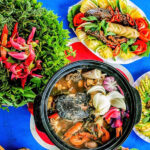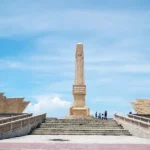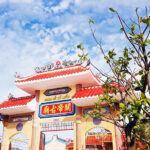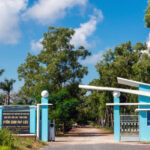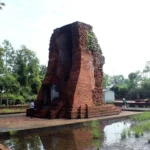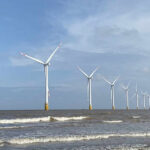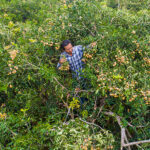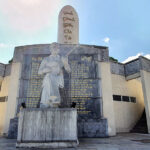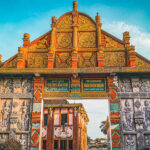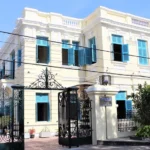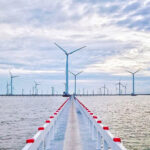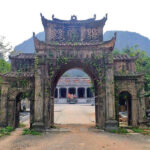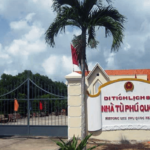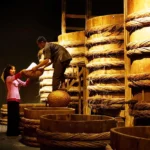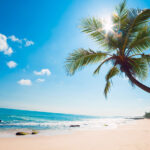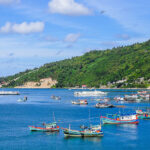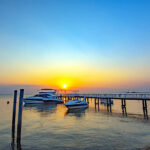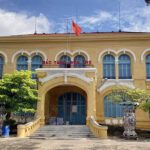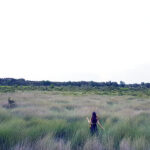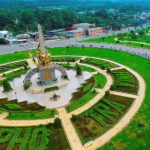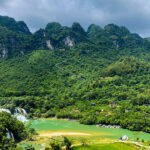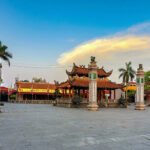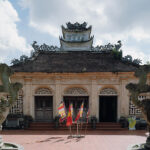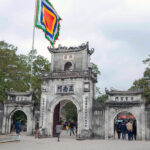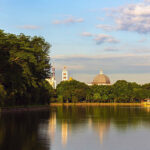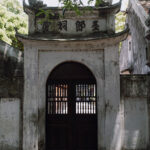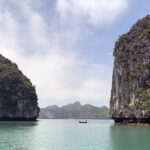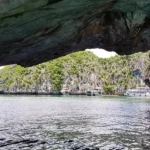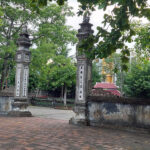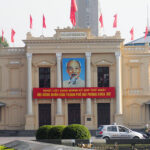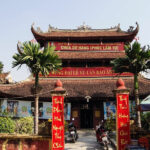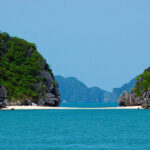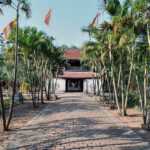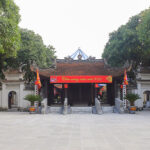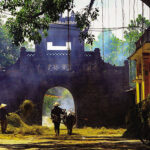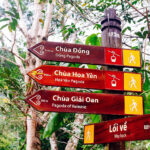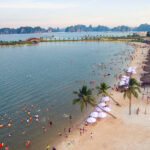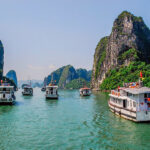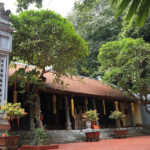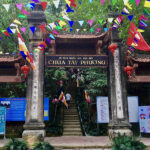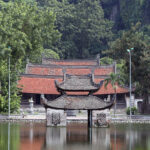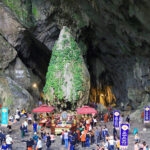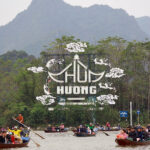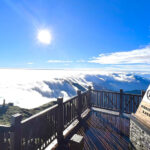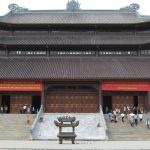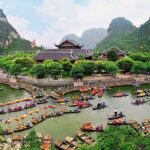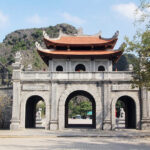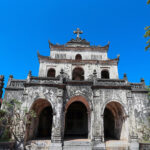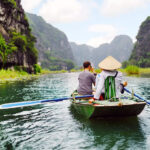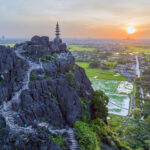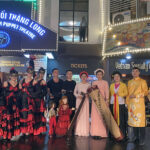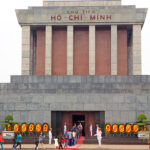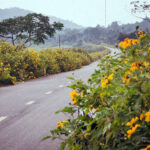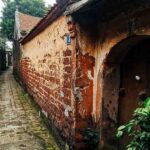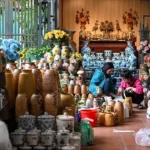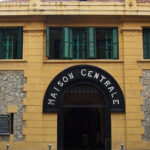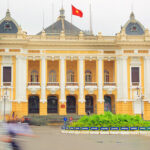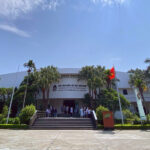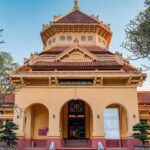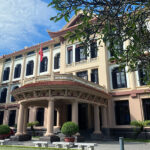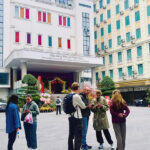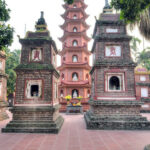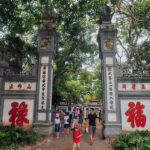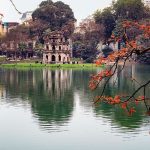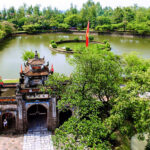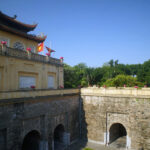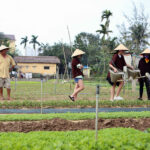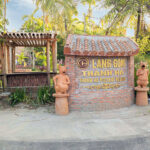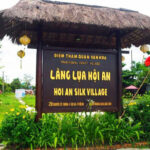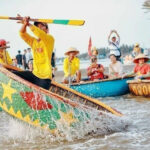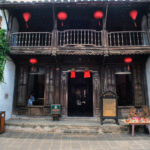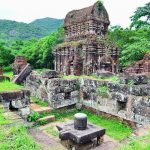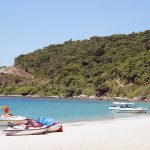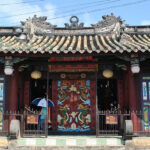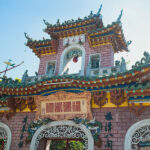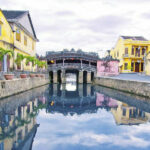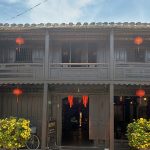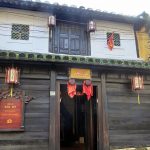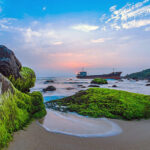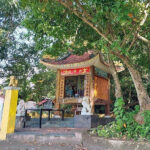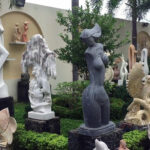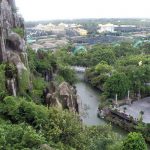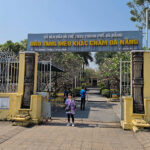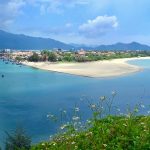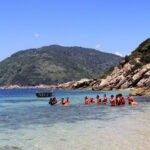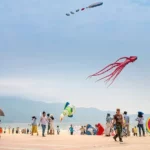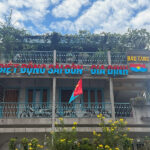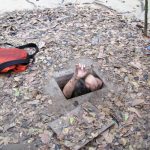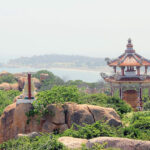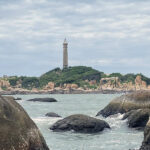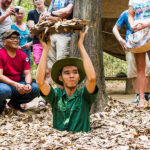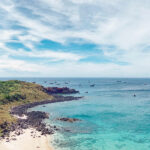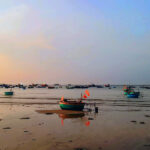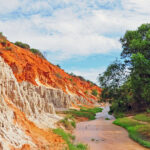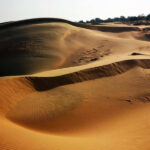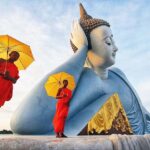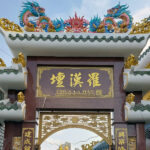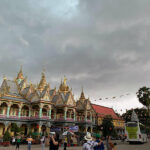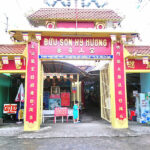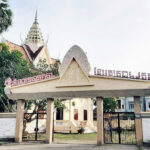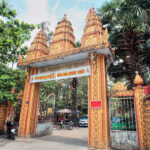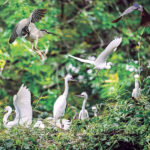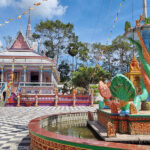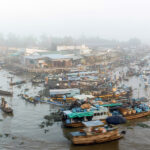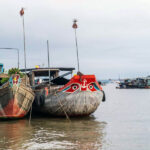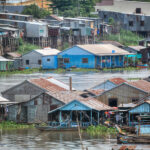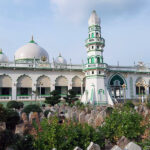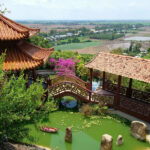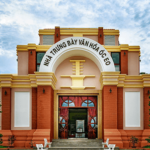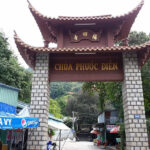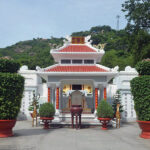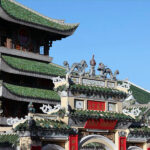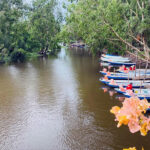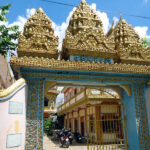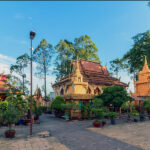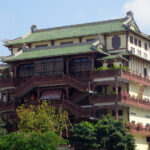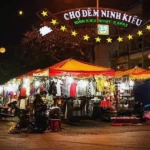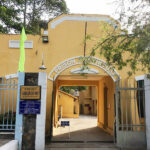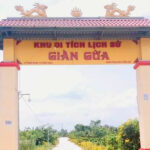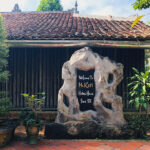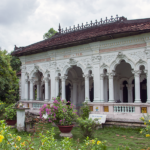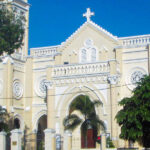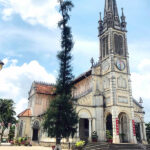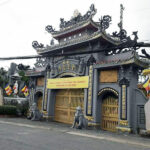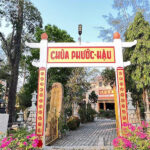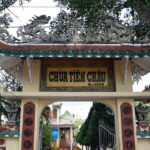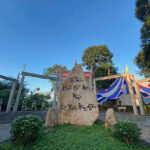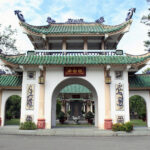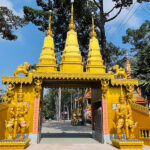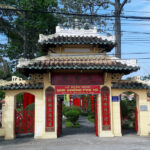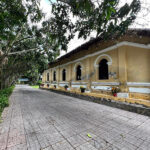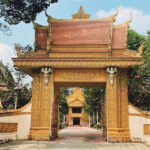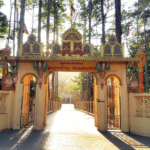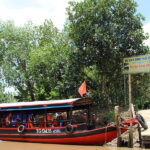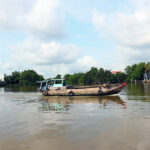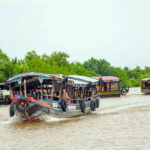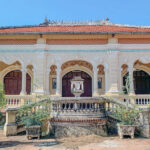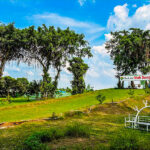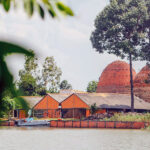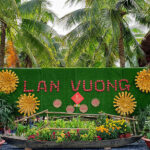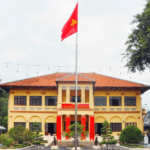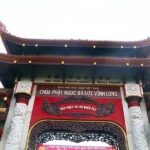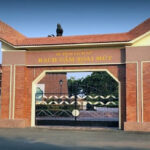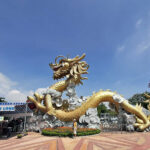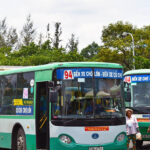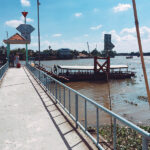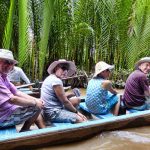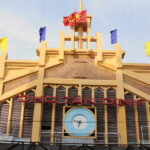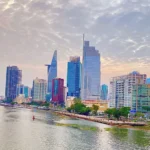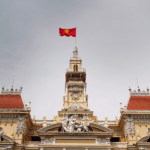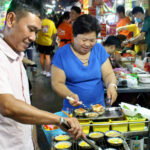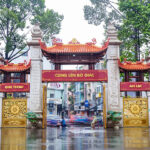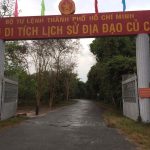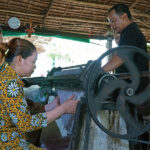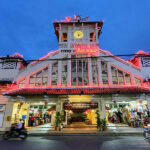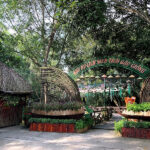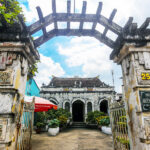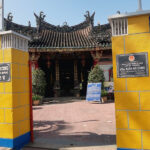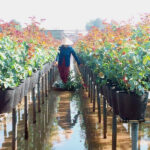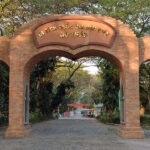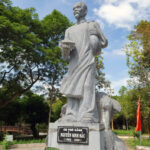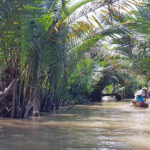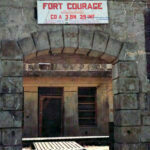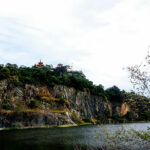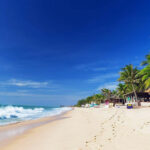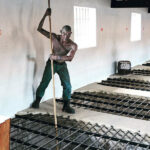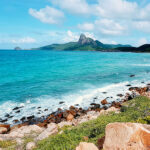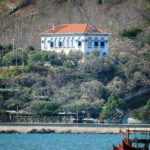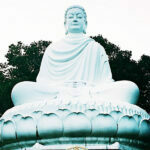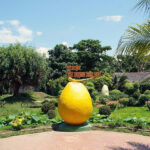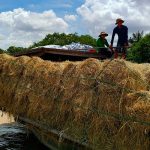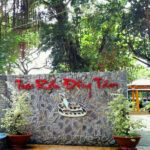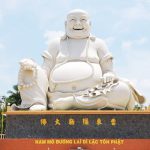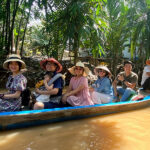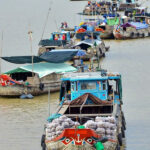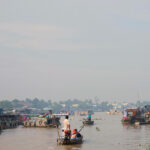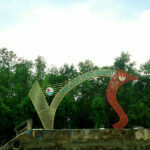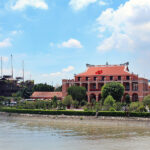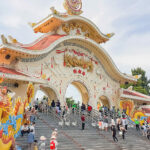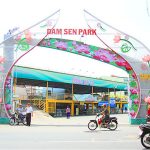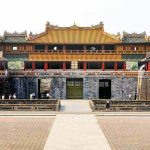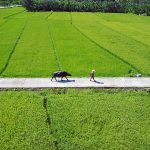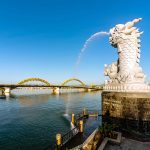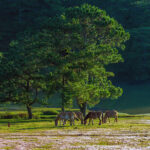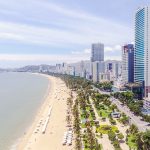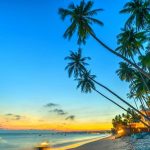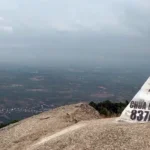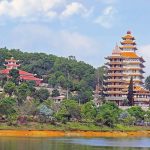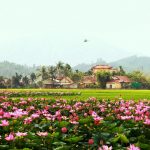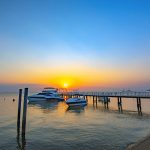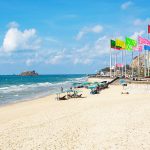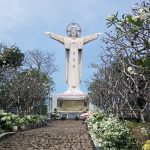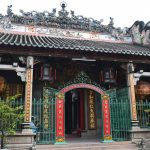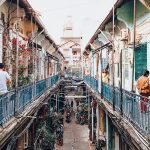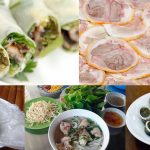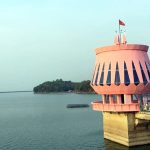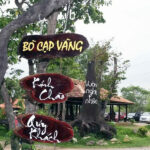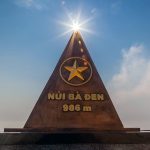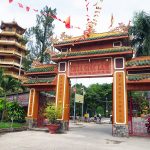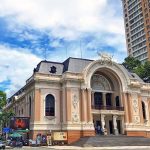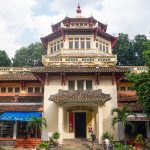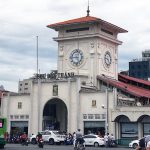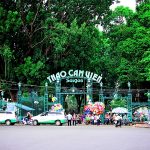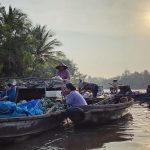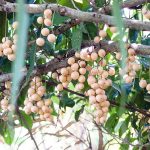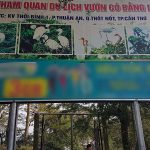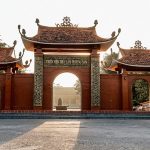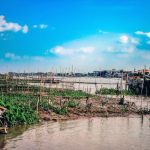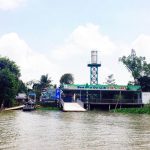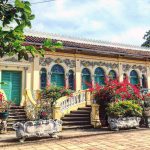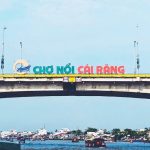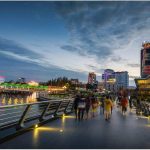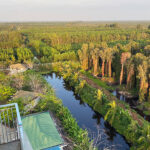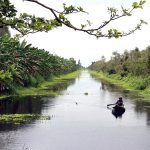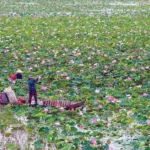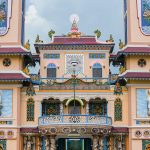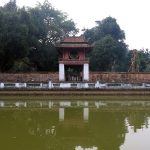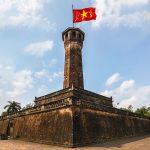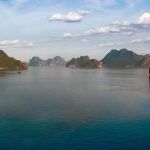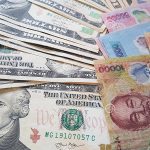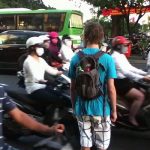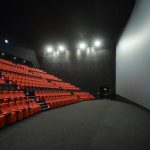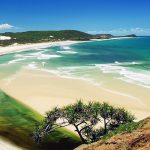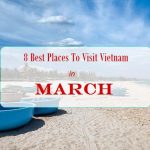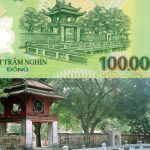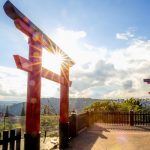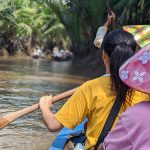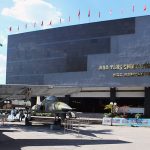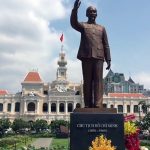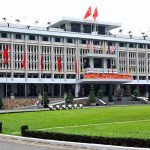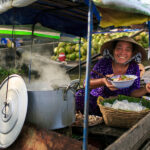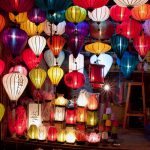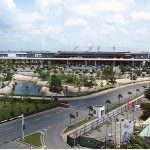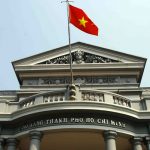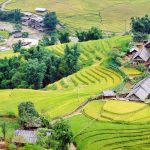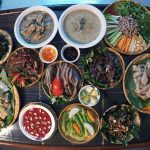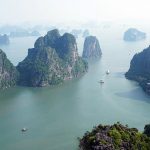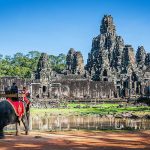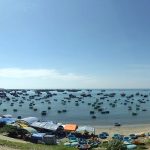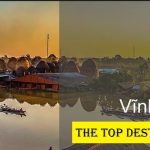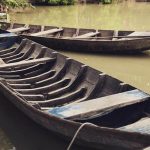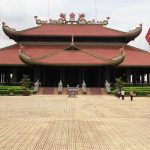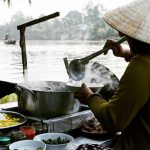Quang Tri has a diverse terrain including hills, plains, sand dunes, beaches running northwest – southeast and especially a cave system, famous as the “Kingdom of Caves”, including the world’s largest cave, Son Doong. In addition, Quang Tri also has Phong Nha – Ke Bang National Park, recognized as a World Natural Heritage. Another outstanding feature of the province is its many historical relics marking Vietnam’s wars, attracting a large number of tourists who want to visit, explore, and research.
Table of Contents
General information about Quang Tri
Quang Tri is located on the central coast, with its administrative center in Dong Hoi ward. Quang Tri borders Ha Tinh province to the north, Hue city to the south, Laos to the west and the East Sea to the east. After merging with Quang Binh in July 2025, the (new) Quang Tri province has a natural area of 12,700 km².
What is the best time to visit Quang Tri?
Located in the humid tropical monsoon region, transitioning between subtropical monsoon and tropical monsoon climates, Quang Tri has harsh weather, divided into two distinct seasons, the rainy season from September to March of the following year, the dry season from April to August.
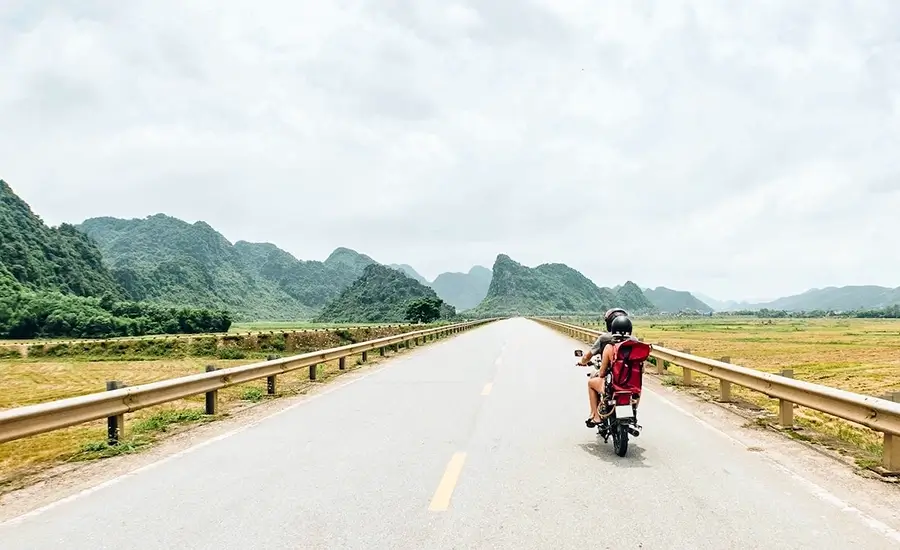
The average annual temperature fluctuates around 25 degrees Celsius, the highest in July (over 40 degrees Celsius) and the lowest in January (3-5 degrees Celsius in mountainous areas). “A Foehn” is most evident from May to August. From October to February, Quang Tri is often affected by the Northeast monsoon with rain that can easily cause storms, floods, flash floods, landslides, and tornadoes.
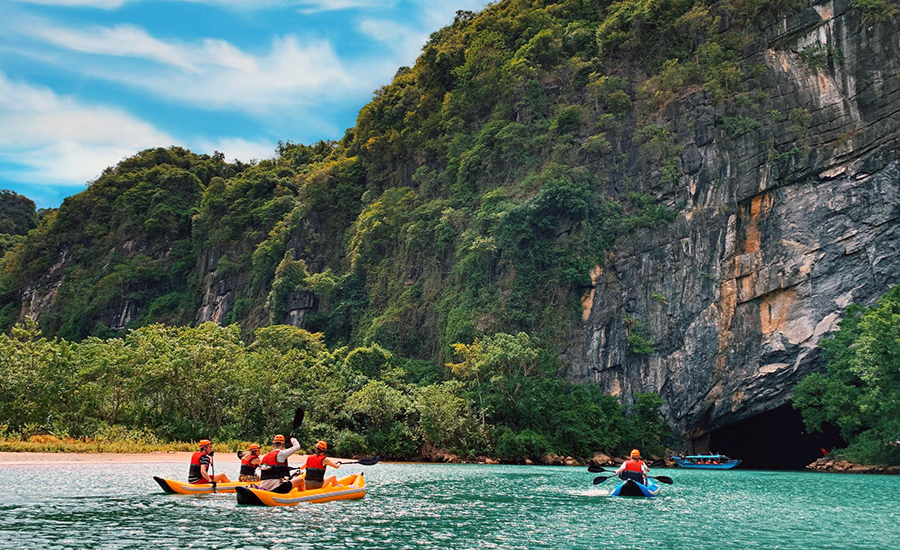
kayak in Phong Nha – Ke Bang (photo source: collected)
Traveling in the rainy season, visitors will have limited mobility, and activities such as swimming in the sea and exploring caves are also difficult to carry out. However, for those who love to explore, the northern part of Quang Tri in the rainy season has its own interesting features. Visitors can wade through rivers and streams, kayak and SUP, from August to November.
How to get there?
By air
Quang Tri province’s airport is Dong Hoi, located in Dong Thuan ward. Currently, the airport only accepts domestic flights, there are no international connections. From Hanoi and Ho Chi Minh City, there are direct flights to Dong Hoi with round-trip fares from 2 to 3 million VND. The frequency of flights to Quang Binh is not much, usually only 2 flights per day. Flight time from Hanoi to Dong Hoi is nearly 1 hour, from Ho Chi Minh City to Dong Hoi is nearly 2 hours.
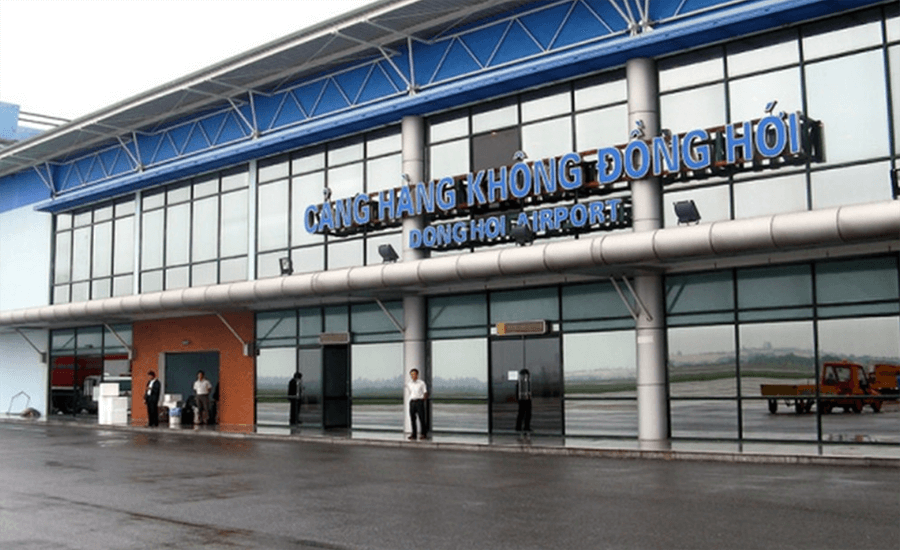
In addition, visitors can choose the neighboring airport in Phu Bai (Hue City). Flight frequency from Hanoi and Ho Chi Minh City to Hue City is higher than Dong Hoi, and there are international flights. Phu Bai Airport is 90 km from Dong Ha ward along National Highway 1A and 105 km along CT01 expressway.
By roadway
Quang Tri is located on National Highway 1A, convenient for traveling by road. Visitors can also follow Ho Chi Minh Road and CT01 expressway. Currently, CT01 expressway has opened the route from Hanoi to Vung Ang (Ha Tinh), the time to reach Quang Tri province is about 6 hours.
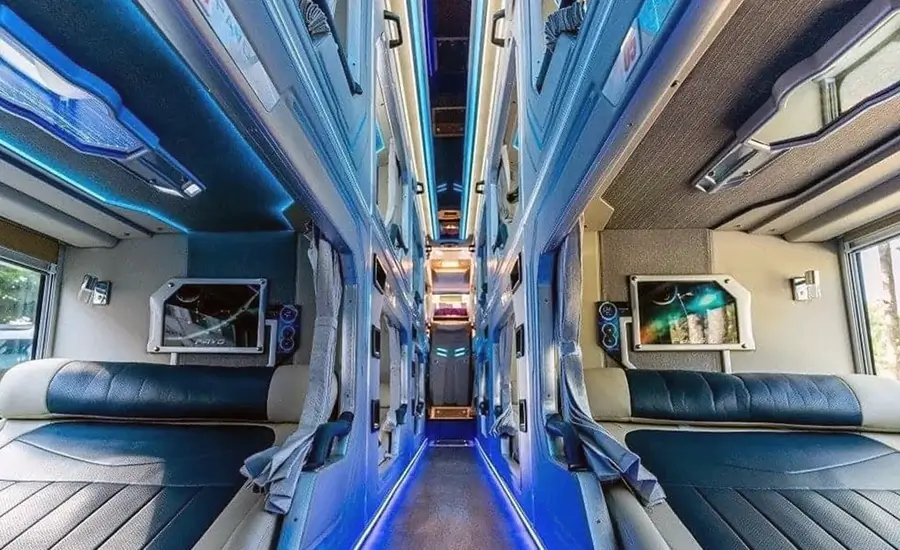
Inside a sleeper bus to Quang Tri.
In addition to rent private car, visitors can choose many bus companies running the North – South route and vice versa. From Hanoi, there are Hung Long, Phuong Trang, Dong Hien, Camel Travel, Quoc Vuong, Thien Trung, Quang Dung, Hoang Long. Sleeper bus fares range from 300,000 VND to 800,000 VND one way per person, depending on the departure point. From Ho Chi Minh City, there are Hoang Long, A Ba, and Loc Thuy bus companies with one-way fares of 400,000-800,000 VND per person. The journey takes about 20 hours.
To turn around Quang Tri, tourist can hire a taxi or rent a private car. Motorbikes can be rented at hotels for 100,000-150,000 VND per day.
Railway
The Thong Nhat train, including the express trains SE1-2 and SE3-4, and the tourist train SE19-20, all stop at Dong Hoi and Dong Ha stations.
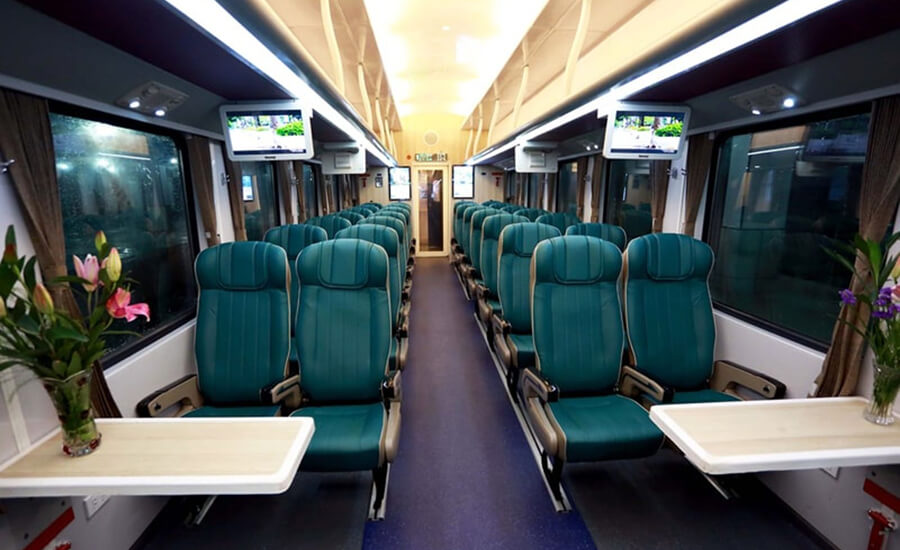
Inside a soft seat-air cabin.
Ticket prices range from 400,000 VND to 1.3 million VND depending on the departure point, train type, and seat/bed class.
Accommodation in Quang Tri
Accommodation services in Quang Tri are diverse, from resorts, hotels, motels to homestays, farmstays or campsites. Accommodation areas for tourists in Quang Tri are mainly concentrated in Dong Hoi ward, Dong Ha, Phong Nha commune, famous beach resorts.
In Dong Hoi, visitors can choose to stay in central areas such as Ly Thuong Kiet street, Tran Hung Dao street or hotels with beautiful locations near Nhat Le beach on Truong Phap street. 4-5 star hotels in the city include Melia Vinpearl Quang Binh, Muong Thanh Holiday, Muong Thanh Luxury Nhat Le, Sun Spa Resort, Celina Peninsula Resort, Gold Coast, Saigon Quang Binh… with prices from 600,000 VND to 2 million VND per night.
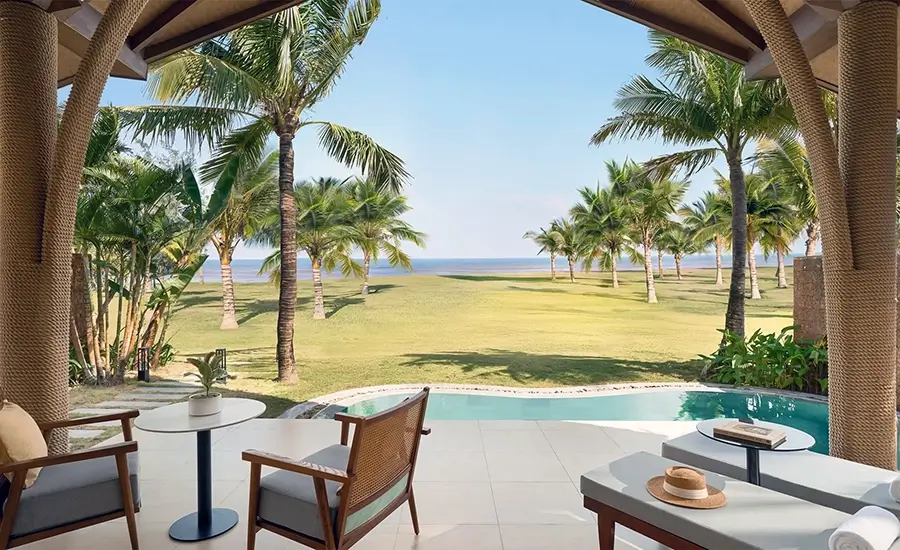
Voco resort in Dong Hoi
Phong Nha, Le Thuy, Bo Trach communes all exploit tourism and also have accommodation, with a variety of prices. Specifically, in the Phong Nha – Ke Bang National Park area, visitors should choose resorts close to nature such as Chay Lap Farmstay, Nguyen Shack – Phong Nha Eco, Phong Nha Coco Riverside, Phong Nha Lake House, Lucky Home… Each night here costs from 400,000 to 2 million VND per room for two people.
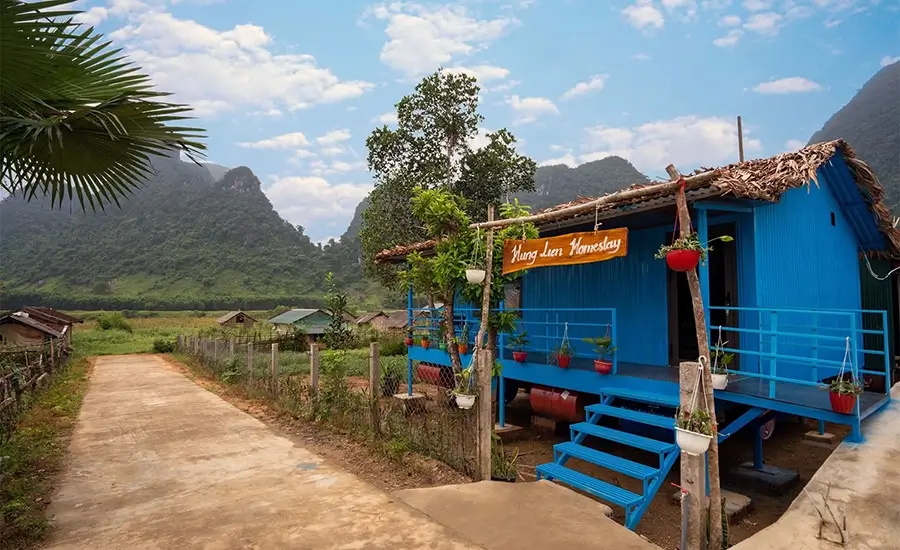
A homestay in Phong Nha area.
Blue Diamond Retreat eco-tourism area with diverse nature exploration activities is located in Phong Nha commune, separate from residential areas, hidden in the heart of the world natural heritage Phong Nha – Ke Bang National Park. This place is easy to access by means of transport from the center of Phong Nha, travel time is about 15 minutes. Overnight rooms range from 420,000 VND to more than 1.2 million VND per person.
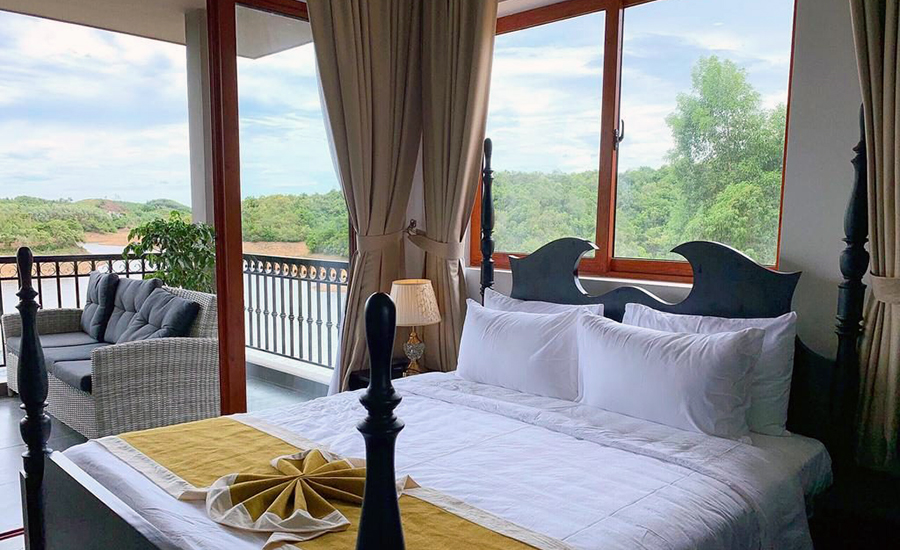
A view from hotel in Phong Nha (photo source: collected).
In Minh Hoa commune, the “weather-adaptive” tourism model has many accommodation options for both the dry and rainy seasons. Tu Lan Lodge costs from 1.1 million VND per night. There are also many spacious and comfortable homestays, with an area of 26 to 40 m², suitable for 1-3 people, priced from 900,000 VND per night. In Dong Ha ward, tourists choose hotels such as Saigon – Dong Ha, Muong Thanh – Quang Tri, Golden Hotel, Khai Hoan Hotel, Huu Nghi Hotel with prices ranging from 500,000 VND to 1 million VND per night. More affordable motels and hotels have prices ranging from around 150,000 VND.
Tourist attractions in Quang Tri
Quang Tri is famous for many historical relics marking the nation’s wars. In addition, the province is also famous for its cave system, national park, historical relics, beaches…and so on.
Nature and wildlife areas
Phong Nha – Ke Bang National Park
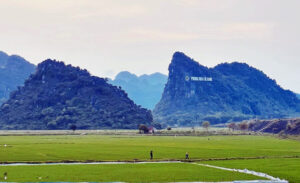 The national park is located in Bo Trach and Minh Hoa communes, about 50 km from Dong Hoi ward. There are more than 400 caves, with a total length of 220 km, and three main rivers: Chay River, Son River, and Trooc River.
The national park is located in Bo Trach and Minh Hoa communes, about 50 km from Dong Hoi ward. There are more than 400 caves, with a total length of 220 km, and three main rivers: Chay River, Son River, and Trooc River.
It covers an area of 85,754 hectares. This complex is a part of the area of the oldest limestone mountains in Asia which were taken shape 400 million years ago. In addition, it contains special values of the formation and development of the earth. Primitive forest accounts for 94% of the area of the entire forest so its biodiversity is richest among Vietnamese forests. The forest boast 566 floras and 876 faunas, many of which are listed in Vietnam’s Red Book. With the great value, Phong Nha – Ke Bang National Park was recognized as the World Natural Heritage. Visitors will take a short walk around the garden, visit Gio waterfall, and wildlife care areas.
Famous cave systems
Quang Tri has hundreds of beautiful, pristine caves, many of which have received world records.
Phong Nha Cave
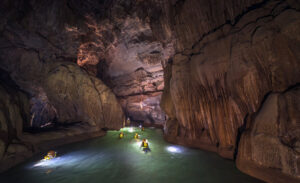 Phong Nha Cave was formed hundreds of millions of years ago by the weathering process inside the limestone mountains, and was evaluated by the British Royal Cave Expedition as a typical wonder of the aesthetic and geological value of the natural world. Phong Nha meets 7 criteria: has the most beautiful underground river; high and wide cave entrance; beautiful sand and reef beaches; beautiful underground lake; has a large and beautiful dry cave; a magical and magnificent stalactite system; the longest water cave.
Phong Nha Cave was formed hundreds of millions of years ago by the weathering process inside the limestone mountains, and was evaluated by the British Royal Cave Expedition as a typical wonder of the aesthetic and geological value of the natural world. Phong Nha meets 7 criteria: has the most beautiful underground river; high and wide cave entrance; beautiful sand and reef beaches; beautiful underground lake; has a large and beautiful dry cave; a magical and magnificent stalactite system; the longest water cave.
To explore Phong Nha Cave, visitors get on a boat at Phong Nha Tourism Center, upstream the Son River for about 30 minutes.
Thien Duong Cave
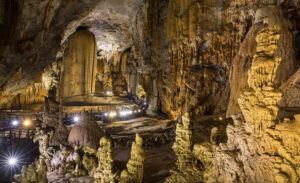 Known as the “underground palace”, Thien Duong Cave is located about 70 km northwest of Dong Hoi ward, next to the western branch of Ho Chi Minh road and about 25 km from Phong Nha Cave. Visitors will have to climb more than 500 steps to reach the cave. Passing through the cave entrance is a large space with many stalactites and stalagmites. With a length of 31.4 km, Thien Duong Cave is considered the longest dry cave in Asia.
Known as the “underground palace”, Thien Duong Cave is located about 70 km northwest of Dong Hoi ward, next to the western branch of Ho Chi Minh road and about 25 km from Phong Nha Cave. Visitors will have to climb more than 500 steps to reach the cave. Passing through the cave entrance is a large space with many stalactites and stalagmites. With a length of 31.4 km, Thien Duong Cave is considered the longest dry cave in Asia.
Thien Duong Cave is a dry cave, without an underground river flowing through it like Phong Nha Cave. Inside Thien Duong Cave there are many magical stalactites and stalagmites. Most of the ground in this cave is soft soil, quite flat so it is convenient for sightseeing and exploration.
Son Doong Cave
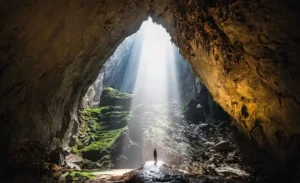 Son Doong Cave is currently the largest natural cave in the world, formed about 2-5 million years ago, 150 m wide, over 200 m high, nearly 9 km long. The estimated capacity of Son Doong Cave is 38.5 million m³. The stalactites of the cave are 14 m high. There is also a 2.5 km long underground river in the cave. The cave has coral reefs and fossilized animal relics. Son Doong also has two “skylights” or sinkholes, where sunlight shines, creating conditions for trees to grow like a tropical forest, one of which is called “Edam Garden”. To go to Son Doong, visitors need to buy a tour, prepare their physical strength, and learn about safety regulations. Tour exploitation time is from late January to August every year. Exploration time: 5 days 4 nights. Average number of guests per tour: 10 people.
Son Doong Cave is currently the largest natural cave in the world, formed about 2-5 million years ago, 150 m wide, over 200 m high, nearly 9 km long. The estimated capacity of Son Doong Cave is 38.5 million m³. The stalactites of the cave are 14 m high. There is also a 2.5 km long underground river in the cave. The cave has coral reefs and fossilized animal relics. Son Doong also has two “skylights” or sinkholes, where sunlight shines, creating conditions for trees to grow like a tropical forest, one of which is called “Edam Garden”. To go to Son Doong, visitors need to buy a tour, prepare their physical strength, and learn about safety regulations. Tour exploitation time is from late January to August every year. Exploration time: 5 days 4 nights. Average number of guests per tour: 10 people.
Tu Lan Cave
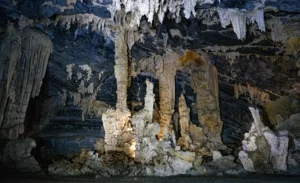 The Tu Lan cave system is located in the primeval forest and limestone mountains with an area of over 650 hectares in Minh Hoa commune. The caves were first explored in 1992 by the British – Vietnamese Cave Exploration Group. By 2022, experts had surveyed and measured more than 25 large and small caves. Tu Lan is a system formed along the Rao Nan River, located outside the Phong Nha – Ke Bang National Park area. The caves in the Tu Lan system have both water caves (with streams flowing inside) and dry caves. Typical caves include Chuot, Hung Ton, Bi Mat, Song, Ken, Kim, and Tien caves. Dry caves often have many beautiful and unique stalactites because they are not washed away during the rainy season. Visitors will be able to swim in the underground cave system, camp in the forest…
The Tu Lan cave system is located in the primeval forest and limestone mountains with an area of over 650 hectares in Minh Hoa commune. The caves were first explored in 1992 by the British – Vietnamese Cave Exploration Group. By 2022, experts had surveyed and measured more than 25 large and small caves. Tu Lan is a system formed along the Rao Nan River, located outside the Phong Nha – Ke Bang National Park area. The caves in the Tu Lan system have both water caves (with streams flowing inside) and dry caves. Typical caves include Chuot, Hung Ton, Bi Mat, Song, Ken, Kim, and Tien caves. Dry caves often have many beautiful and unique stalactites because they are not washed away during the rainy season. Visitors will be able to swim in the underground cave system, camp in the forest…
En cave
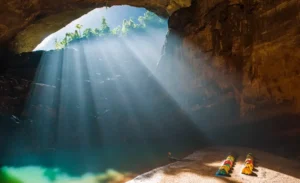 En cave is the third largest in the world, 1.6 km long, passing through a giant limestone block. There are 3 entrances to the cave, of which the largest and most famous cave entrance is 120 m high and 110 m wide, the ceiling is 145 m high in some places and the widest corridor is 200 m. Inside the cave is a winding stream leading to Son Doong Cave. The Hollywood movie Peter Pan had scenes filmed here. The tour to explore Hang En is open from December to the end of September every year. The journey to Hang En lasts two days, with trekking activities such as trekking through the forest, wading through streams, climbing slopes, and exploring Ban Doong – the residence of the Bru – Van Kieu people.
En cave is the third largest in the world, 1.6 km long, passing through a giant limestone block. There are 3 entrances to the cave, of which the largest and most famous cave entrance is 120 m high and 110 m wide, the ceiling is 145 m high in some places and the widest corridor is 200 m. Inside the cave is a winding stream leading to Son Doong Cave. The Hollywood movie Peter Pan had scenes filmed here. The tour to explore Hang En is open from December to the end of September every year. The journey to Hang En lasts two days, with trekking activities such as trekking through the forest, wading through streams, climbing slopes, and exploring Ban Doong – the residence of the Bru – Van Kieu people.
Pygmy Cave
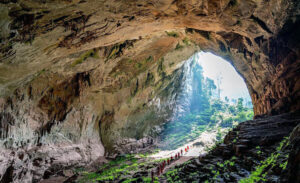 Pygmy is the fourth largest cave in the world, located deep in Phong Nha – Ke Bang National Park, discovered in 1997. The cave entrance is about 100 m high and wide, 845 m long. During the day, light can penetrate the cave. In Pygmy Cave, water flows from the ceiling, used for drinking, cooking and daily activities. The light shines deep into the cave, helping many ferns grow well.
Pygmy is the fourth largest cave in the world, located deep in Phong Nha – Ke Bang National Park, discovered in 1997. The cave entrance is about 100 m high and wide, 845 m long. During the day, light can penetrate the cave. In Pygmy Cave, water flows from the ceiling, used for drinking, cooking and daily activities. The light shines deep into the cave, helping many ferns grow well.
The cave exit is also a camping site, where visitors can see many vines and bamboos tied together by locals to climb up the cave wall to exploit bird’s nests and honey.
Kong Collapse
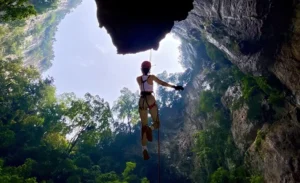 Kong Collapse belongs to the Tiger Cave system in the Phong Nha – Ke Bang area, shaped like a giant monkey head in the movie Kong: Skull Island, which was filmed in Quang Binh (now is Quang Tri Province). Kong Collapse is 450 m deep from mouth to bottom, one of the deepest sinkholes in the world. Kong Sinkhole Exploration is a challenging adventure tour in Vietnam, with a 100m zipline, 23km hike, 300m swim and a 7km cave exploration.
Kong Collapse belongs to the Tiger Cave system in the Phong Nha – Ke Bang area, shaped like a giant monkey head in the movie Kong: Skull Island, which was filmed in Quang Binh (now is Quang Tri Province). Kong Collapse is 450 m deep from mouth to bottom, one of the deepest sinkholes in the world. Kong Sinkhole Exploration is a challenging adventure tour in Vietnam, with a 100m zipline, 23km hike, 300m swim and a 7km cave exploration.
The journey requires hours of walking through small trails with continuous ups and downs. During the journey, visitors will pass through Pygmy Cave, camp in Over Cave.
Chay River – Dark Cave
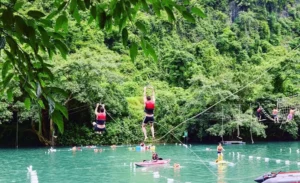 Chay River originates from the limestone mountain range flowing through the villages, combined with Dark Cave, a cave with an ancient stalactite system typical of the geological formation process of Phong Nha – Ke Bang area, forming a natural exploration tourist route.
Chay River originates from the limestone mountain range flowing through the villages, combined with Dark Cave, a cave with an ancient stalactite system typical of the geological formation process of Phong Nha – Ke Bang area, forming a natural exploration tourist route.
Currently, Chay River – Dark Cave is being exploited in the form of an adventure with many services such as zipline river bathing, zipline cave exploration, kayaking to explore Chay River, swimming through Thuy Tien Lake in Dark Cave and healthy mud baths…
Ngang Pass
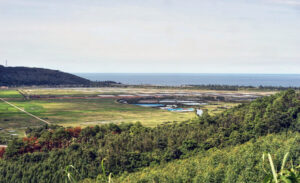 Being the natural border between Ha Tinh and Quang Tri provinces, Ngang pass crosses the Hoanh Son range, a key checkpoint on National Highway 1A. The pass is 6 km long, with a peak of about 250 m. At the top of the pass, there is still “Heaven’s Gate” – a relic of the Hoanh Son gate built in 1833. In the past, Hoanh Son played an important role in people’s lives, and the poetic and open beauty of this place also became a source of inspiration for many writers.
Being the natural border between Ha Tinh and Quang Tri provinces, Ngang pass crosses the Hoanh Son range, a key checkpoint on National Highway 1A. The pass is 6 km long, with a peak of about 250 m. At the top of the pass, there is still “Heaven’s Gate” – a relic of the Hoanh Son gate built in 1833. In the past, Hoanh Son played an important role in people’s lives, and the poetic and open beauty of this place also became a source of inspiration for many writers.
Since 2004, Ngang pass road tunnel has been built and put into use. However, many tourists still love to experience and enjoy the majestic pass and step up the mossy steps in Hoanh Son.
Bang Mineral Hot Spring
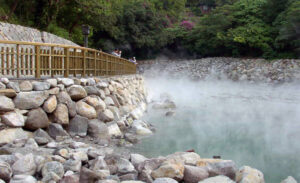 Located 60km south of Dong Hoi ward, in Kim Ngan Commune. Bang mineral Hot Spring has been recorded as the only hot water source in Vietnam with an on-spot temperature of 105C. The mineral water with a composition of many precious elements has become an internationally prestigious mineral water source.
Located 60km south of Dong Hoi ward, in Kim Ngan Commune. Bang mineral Hot Spring has been recorded as the only hot water source in Vietnam with an on-spot temperature of 105C. The mineral water with a composition of many precious elements has become an internationally prestigious mineral water source.
In addition, this hot spring is potential for resorts. Investments have been made on several ten hectares of land area for the development of swimming pools, spas, accommodation and tourist services to make Bang hot spring a favorite resort and wellness tourism destination of both international and domestic visitors.
Mooc Stream
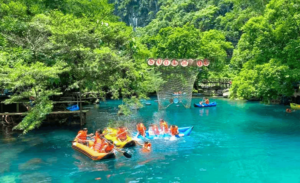 Mooc Stream tourist area is located in Phong Nha commune, about 70 km from Dong Hoi, on the western branch of Ho Chi Minh road. The stream is located right in the middle of the valley, surrounded by limestone mountains, along the banks of Chay River.
Mooc Stream tourist area is located in Phong Nha commune, about 70 km from Dong Hoi, on the western branch of Ho Chi Minh road. The stream is located right in the middle of the valley, surrounded by limestone mountains, along the banks of Chay River.
The stream here is green all year round, on sunny summer days, the water is even greener. There are many fun and exploratory activities here such as swimming races, kayaking, fishing, ziplining. Visitors must buy entrance tickets and tickets for each game.
The best beaches and islands
Cua Tung Beach
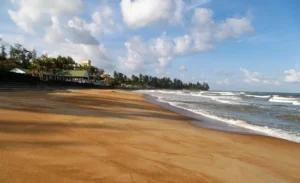 Cua Tung beach, also known as “Queen of beaches”, is located about 30 km from the center of Dong Ha Ward. In the early 20th century, this was one of the top resorts for the French in the Central region, with a long, gentle white sandbank. Previously, the beach was nearly a kilometer long, in the shape of a crescent moon.
Cua Tung beach, also known as “Queen of beaches”, is located about 30 km from the center of Dong Ha Ward. In the early 20th century, this was one of the top resorts for the French in the Central region, with a long, gentle white sandbank. Previously, the beach was nearly a kilometer long, in the shape of a crescent moon.
Since 2003, the province has built many projects at the Ben Hai estuary, including breakwaters, bridges, and Cua Tung fishing port, causing the flow to change, the beach to be eroded, the sand to be washed away, and the water to hit the embankment.
Cua Viet Beach
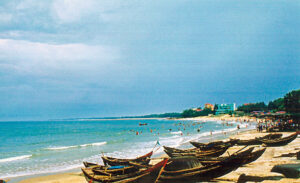 Cua Viet Beach is 17 km from Dong Ha Ward center, 15 km south of Cua Tung. Cua Viet Beach has a large area, with its own unique beauty with a smooth, flat white sand beach. Coming to Cua Viet beach, you will be able to admire the clear blue water blending with the clouds and sky, parallel to the sea is a long white sand beach like a white silk strip across the beach.
Cua Viet Beach is 17 km from Dong Ha Ward center, 15 km south of Cua Tung. Cua Viet Beach has a large area, with its own unique beauty with a smooth, flat white sand beach. Coming to Cua Viet beach, you will be able to admire the clear blue water blending with the clouds and sky, parallel to the sea is a long white sand beach like a white silk strip across the beach.
Cua Viet Beach is sheltered by two high cliffs, so it is quite wind-proof and the sea is calmer. Therefore, the beach is very safe for everyone, including children and women. Currently, many infrastructure – accommodation facilities have also been invested in Cua Viet beach, meeting the needs of tourists.
Nhat Le Beach
About 1km from the center of Dong Hoi ward, Nhat Le beach is likened to a fairy painting with the most romantic lyrical beauty among the coastlines in Quang Tri province, with white sand and clear blue water with a wild look.
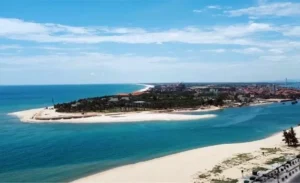 Nhat Le beach always attracts many tourists to swim and enjoy fresh, nutritious seafood, the most prominent of which is the sea snake dish processed into many dishes, including sea snake wine – a famous and attractive wine of Nhat Le sea.
Nhat Le beach always attracts many tourists to swim and enjoy fresh, nutritious seafood, the most prominent of which is the sea snake dish processed into many dishes, including sea snake wine – a famous and attractive wine of Nhat Le sea.
At dawn, the scene here seems to be dressed in a new coat by nature, radiant in the morning sunlight. When night falls, the streets are lit up, the boats preparing to go out to sea to fish turn on their headlights and release magical halos into the air.
On November 15, 2014, the Vietnam Record Organization awarded the Nhat Le beach a record certificate to be recognized in the top 10 most attractive sea tourism destinations in Vietnam. And before that, Nhat Le seaport had become a national historical and cultural relic.
Da Nhay beach
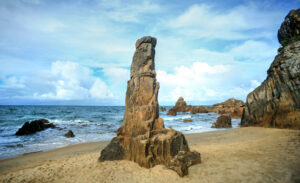 Da Nhay beach is a scenic spot in Bo Trach commune, on Highway 1A, about 26 km north of Dong Hoi. The coastal rocks are weathered and eroded by seawater over time, creating natural animal statues such as the male and female rocks, elephants, tigers, etc. on the coast.
Da Nhay beach is a scenic spot in Bo Trach commune, on Highway 1A, about 26 km north of Dong Hoi. The coastal rocks are weathered and eroded by seawater over time, creating natural animal statues such as the male and female rocks, elephants, tigers, etc. on the coast.
In here, visitors can participate in many types of entertainment such as rowing, mountain climbing, hunting, camping. Coc well at Da Nhay beach has very clear water, warm in winter and cool in summer, and is often used by fishermen for worship.
Con Co Island
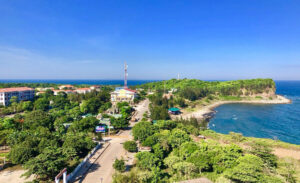 Con Co Island is located about 30 km from the mainland. During the resistance war against the US, people made many achievements and were honored as “Heroic Island”. Today, Con Co focuses on developing historical experience tourism and green tourism. Con Co has an area of 2.3 km² and still retains its wild beauty. Sightseeing spots: flagpole, military hospital bunker, ancient tomb well, traditional house, martyrs memorial, Nghe wharf, Tranh wharf…. The island has many corals, especially red corals, blue stars, sea cucumbers and many other valuable seafood.
Con Co Island is located about 30 km from the mainland. During the resistance war against the US, people made many achievements and were honored as “Heroic Island”. Today, Con Co focuses on developing historical experience tourism and green tourism. Con Co has an area of 2.3 km² and still retains its wild beauty. Sightseeing spots: flagpole, military hospital bunker, ancient tomb well, traditional house, martyrs memorial, Nghe wharf, Tranh wharf…. The island has many corals, especially red corals, blue stars, sea cucumbers and many other valuable seafood.
Currently, the island has seven accommodation service establishments with 73 rooms, serving nearly 300 guests at the same time. There are two ships running the Cua Viet – Con Co island route, including ConCo Tourist (carrying 80 guests) and Chin Nghia (156 guests).
Bao Ninh Peninsula
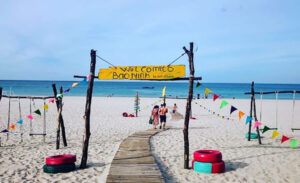 Located in the east, Bao Ninh Peninsula is peaceful between the sea on one side and Nhat Le River on the other. This place is attractive because of the quiet, peaceful space of the wild sky, gentle like a quiet muse next to the bustling, bustling streets; adding color to the beauty of Bao Ninh peninsula lying between two waters. On one side is the endless, raging ocean, on the other side is the poetic, quietly flowing Nhat Le river. All have created a unique natural landscape that can only be found here.
Located in the east, Bao Ninh Peninsula is peaceful between the sea on one side and Nhat Le River on the other. This place is attractive because of the quiet, peaceful space of the wild sky, gentle like a quiet muse next to the bustling, bustling streets; adding color to the beauty of Bao Ninh peninsula lying between two waters. On one side is the endless, raging ocean, on the other side is the poetic, quietly flowing Nhat Le river. All have created a unique natural landscape that can only be found here.
In addition to swimming and sightseeing, visitors can also participate in a number of sports activities such as volleyball, soccer, kite flying, surfing, and parasailing on the beach. The peninsula also has ancient citadel relics and Whale Temple with strong fishermen culture.
Vung Chua – Yen Island
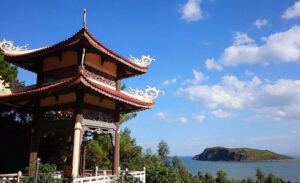 This is a scenic spot in Quang Trach commune, right at the foot of Ngang Pass, about 4 km south, more than 2 km east of National Highway 1A. Vung Chua is a peaceful beach, in the sea there is Yen Island, considered a screen creating a romantic scene.
This is a scenic spot in Quang Trach commune, right at the foot of Ngang Pass, about 4 km south, more than 2 km east of National Highway 1A. Vung Chua is a peaceful beach, in the sea there is Yen Island, considered a screen creating a romantic scene.
Dragon Mountain in this area is the resting place of General Vo Nguyen Giap. Every day, thousands of people from all over the country come here to offer incense, especially crowded during holidays and Tet. Visitors need to contact in advance for information on opening days and hours.
Historical relic sites
Quang Tri Citadel
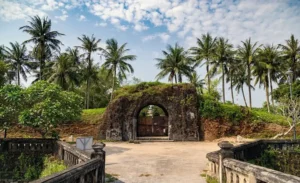 Quang Tri Citadel is a special national monument of Vietnam, built for nearly 28 years (1809-1837). The citadel is located in Quang Tri ward, about 2 km east of National Highway 1A.
Quang Tri Citadel is a special national monument of Vietnam, built for nearly 28 years (1809-1837). The citadel is located in Quang Tri ward, about 2 km east of National Highway 1A.
The citadel is square in shape, with a wall perimeter of more than 2,000 m, more than 4 m high, and more than 12 m thick at the foot, surrounded by a moat system, with four protruding bastions at the four corners of the citadel. The citadel was built in the style of Vietnamese citadel architecture with square surrounding walls made of large-sized burnt bricks; bonded with lime, molasses and some other folk additives. The citadel has four main gates in the East, West, South and North. From Quang Tri citadel, you can go to the south or north by river, road or sea. This place was devastated by huge bombs during the war.
Truong Son Martyrs’ Cemetery
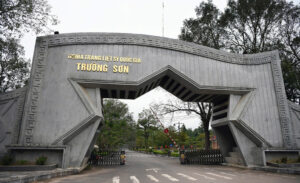 Truong Son Martyrs’ Cemetery is located in Con Tien Commune, about 25 km northwest of Dong Ha ward, and about 20 km from National Highway 1A. The cemetery covers an area of 140,000 m², on three hills, next to the upper Ben Hai River. The cemetery was built from October 24, 1975 and completed on April 10, 1977. This is the largest martyrs’ cemetery in Vietnam, the resting place of more than 10,200 martyrs, divided into 10 areas according to localities. The cemetery belongs to the system of special national historical relics.
Truong Son Martyrs’ Cemetery is located in Con Tien Commune, about 25 km northwest of Dong Ha ward, and about 20 km from National Highway 1A. The cemetery covers an area of 140,000 m², on three hills, next to the upper Ben Hai River. The cemetery was built from October 24, 1975 and completed on April 10, 1977. This is the largest martyrs’ cemetery in Vietnam, the resting place of more than 10,200 martyrs, divided into 10 areas according to localities. The cemetery belongs to the system of special national historical relics.
The Memorial of the Nation to Soldiers’ Sacrifices has three sides representing the three Indochinese countries leaning on each other to fight the enemy. Between sections 4 and 5 is a group of monuments in memory of the heroism of Battalion 559 and Vietnam-Laos solidarity.
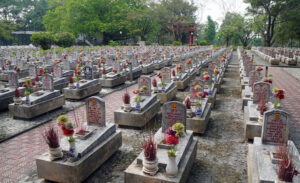 The cemetery is the resting-place of soldiers who fell on the Ho Chi Minh Trail, which has become part of the history of anti-American war and in battlefields in the Central part of the country. This is the biggest highly artistic memorial site showing the people deep sorrow, gratitude and respect for those who have sacrificed their lives for the liberation of the nation.
The cemetery is the resting-place of soldiers who fell on the Ho Chi Minh Trail, which has become part of the history of anti-American war and in battlefields in the Central part of the country. This is the biggest highly artistic memorial site showing the people deep sorrow, gratitude and respect for those who have sacrificed their lives for the liberation of the nation.
Every year, it welcomes thousands of visitors from around the country. Many foreigners have crossed thousands miles to visit it.
Vinh Moc Tunnels
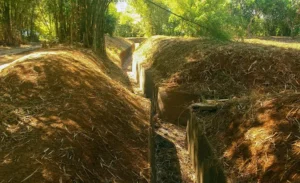 Vinh Moc Tunnels (in Vinh Moc village, Cua Tung commune) is a military-civilian project during the Vietnam War by the Democratic Republic of Vietnam to fight against attacks by the Republic of Vietnam and the United States of America.
Vinh Moc Tunnels (in Vinh Moc village, Cua Tung commune) is a military-civilian project during the Vietnam War by the Democratic Republic of Vietnam to fight against attacks by the Republic of Vietnam and the United States of America.
The tunnel system existed north of Ben Hai River, Hien Luong Bridge during the years 1965-1972. The tunnels are composed of three floors, the deepest floor is 22 m below ground level, ensuring safe and convenient eating, living, and activities for hundreds of people.
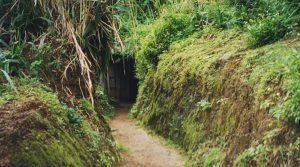 Along both sides of the tunnel, many apartments were built, each apartment has enough space for three to four people. Inside the tunnels, there are three wells, a hall (with a capacity of 50 people), an infirmary, a maternity home, a surgical station, a Hoang Cam kitchen, a rice warehouse, a telephone station, etc.
Along both sides of the tunnel, many apartments were built, each apartment has enough space for three to four people. Inside the tunnels, there are three wells, a hall (with a capacity of 50 people), an infirmary, a maternity home, a surgical station, a Hoang Cam kitchen, a rice warehouse, a telephone station, etc.
Vinh Moc Tunnels is part of the system of tourist attractions in the former demilitarized zone during the Vietnam War and has been recognized as a historical relic of Vietnam.
Khe Sanh Combat Base
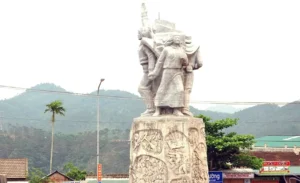 Khe Sanh is a valley surrounded entirely by rolling mountains and forest. It’s located on Highway 9 in Khe Sanh commune, about 60 km from the center of Dong Ha ward. Geographically, it is very similar to Dien Bien Phu. The US and Republic of Vietnam armies built Khe Sanh into the largest stronghold that was believed to be unassailable, in the Highway 9 defense line.
Khe Sanh is a valley surrounded entirely by rolling mountains and forest. It’s located on Highway 9 in Khe Sanh commune, about 60 km from the center of Dong Ha ward. Geographically, it is very similar to Dien Bien Phu. The US and Republic of Vietnam armies built Khe Sanh into the largest stronghold that was believed to be unassailable, in the Highway 9 defense line.
More than 10,000 men not to mention other troops ready to intervene were stationed there. This is where major battles took place in the Route 9 – Khe Sanh campaign in 1968 and the Route 9 – Southern Laos campaign in 1971. The Ta Con base cluster with its field airport preserves many items of the 1968 victory: exhibition houses, trenches, command bunkers, barbed wire fences, runways, aircraft, artillery, tanks and many other items.
Dong Hoi Citadel & Quang Binh Border Gate
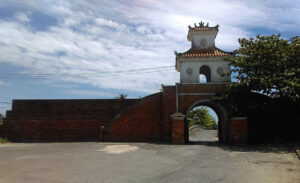 Dong Hoi Citadel, also known as Quang Binh Citadel, is a military architectural relic located in the center of Dong Hoi ward. The citadel was formed from Dong Hai military post in the Thay rampart system, built under the reign of Lord Nguyen Phuc Nguyen to guard Quang Binh gate and fight against Lord Trinh. During the reigns of Gia Long and Minh Mang, the citadel was expanded and solidly built in Vauban architecture, becoming the capital of Quang Binh province (now is Quang Tri province).
Dong Hoi Citadel, also known as Quang Binh Citadel, is a military architectural relic located in the center of Dong Hoi ward. The citadel was formed from Dong Hai military post in the Thay rampart system, built under the reign of Lord Nguyen Phuc Nguyen to guard Quang Binh gate and fight against Lord Trinh. During the reigns of Gia Long and Minh Mang, the citadel was expanded and solidly built in Vauban architecture, becoming the capital of Quang Binh province (now is Quang Tri province).
Quang Binh border gate is an important pass in the Luy Thay system, built in 1631. Quang Binh gate guards the mouth of Dong Hai river, at the confluence of Nhat Le and Le Ky rivers and is the “connecting point” of Dau Mau – Nhat Le rampart. In the past, to go from North to South, one must pass through this gate.
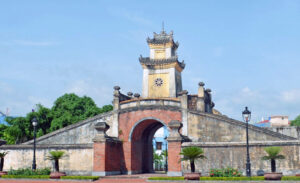 Quang Binh gate was originally built with earth, during the Minh Mang period (1791-1841) it was expanded with solid bricks and stones, guardhouses were built on the gate, and an outer rampart and moat were added. Dong Hai garrison was also expanded and solidly built, to support and protect the gate.
Quang Binh gate was originally built with earth, during the Minh Mang period (1791-1841) it was expanded with solid bricks and stones, guardhouses were built on the gate, and an outer rampart and moat were added. Dong Hai garrison was also expanded and solidly built, to support and protect the gate.
The citadel was mostly destroyed by the US air force during Operation Rolling Thunder. Today, the remaining relics of the citadel include Quang Binh border gate, the citadel gates and some restored sections of the citadel wall.
Tam Toa Church
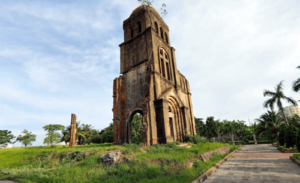 Tam Toa Church is a Catholic church located on Nguyen Du Street, Dong Hoi Ward, Quang Tri Province. This place used to be the church of Tam Toa Parish, considered one of the most beautiful churches in Vietnam. In 1887, Tam Toa Church was built, becoming the church of Tam Toa Parish, which originated from Dong Hai Parish, one of the first parishes in the history of Catholicism in Vietnam. The church was built in the Portuguese architectural style.
Tam Toa Church is a Catholic church located on Nguyen Du Street, Dong Hoi Ward, Quang Tri Province. This place used to be the church of Tam Toa Parish, considered one of the most beautiful churches in Vietnam. In 1887, Tam Toa Church was built, becoming the church of Tam Toa Parish, which originated from Dong Hai Parish, one of the first parishes in the history of Catholicism in Vietnam. The church was built in the Portuguese architectural style.
In the 8 years from 1964 to 1972, the US Air Force and Navy repeatedly air-raided Dong Hoi. Most of the town was flattened by bombs, Tam Toa Church was also damaged. The most serious was the air-raid on February 11, 1965, when the church was destroyed by a bomb, leaving only the bell tower with many bullet holes. After the war ended and Vietnam was unified, the church ruins were kept by the Vietnamese government as a war relic. and currently, it is a provincial-level historical and cultural relic.
Ancients villages
Bich La Village
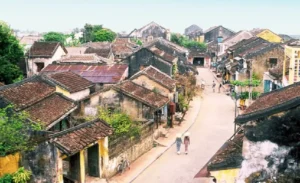 The 500-year-old Bich La Ancient Village in Trieu Phong Commune is famous for its sacred land and special relics. There are many religious architectural works around the village. Every year, there is a communal house fair, attracting many tourists from all over the country.
The 500-year-old Bich La Ancient Village in Trieu Phong Commune is famous for its sacred land and special relics. There are many religious architectural works around the village. Every year, there is a communal house fair, attracting many tourists from all over the country.
This place also preserves many folk games and entertainments such as bai choi (a combination of arts in Central Vietnam including music, poetry, acting, painting and literature, providing recreation, entertainment and socialising within village communities), poetry reading, playing clay chicken, and writing calligraphy.
Canh Duong Sea Village
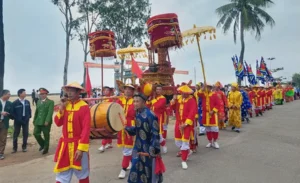 The village is by the National Highway No 1A and close to Roon Harbor Mouth, very convenient for traffic between the North and the South. Canh Duong is the most bustling and prosperous village in the coastal area of Quang Tri province. Moreover, it also has a long history and cultural tradition. In 1643, people from Nghi Loc, Nghe An Province chose the sandy area near Roon Harbor Mouth for their settlement. With the passage of time, the village has become crowded. Fishing, seafood processing and trade have been increasingly thriving. In addition to economic development, residents also pay much attention to cultural activities. Every spring, the village organizes festival with the ritual of deities procession, and traditional games such as human chess, rice-cooking competition, boat race, and singing contest.
The village is by the National Highway No 1A and close to Roon Harbor Mouth, very convenient for traffic between the North and the South. Canh Duong is the most bustling and prosperous village in the coastal area of Quang Tri province. Moreover, it also has a long history and cultural tradition. In 1643, people from Nghi Loc, Nghe An Province chose the sandy area near Roon Harbor Mouth for their settlement. With the passage of time, the village has become crowded. Fishing, seafood processing and trade have been increasingly thriving. In addition to economic development, residents also pay much attention to cultural activities. Every spring, the village organizes festival with the ritual of deities procession, and traditional games such as human chess, rice-cooking competition, boat race, and singing contest.
Quang Tri specialties
Vat Giuong porridge
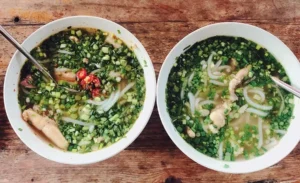 Also known as rice soup, powder porridge or fish porridge, is a Quang Tri specialty. Vat Giuong porridge has a distinctive flavor of rice flour or tapioca flour and snakehead fish. Unlike porridge dishes made from soft, simmered rice, bed porridge is made from thinly rolled flour, cut into small, long strands like the bamboo strips of bed, hence the name. The flavor that makes Vat Giuong porridge is steamed snakehead fish, filtered for meat, crushed head and bones, and squeezed to make broth. When eating, diners will feel the sweetness of the fish, the richness of fried onions mixed with the sweetness of flour, and the spiciness of chili. You must use both chopsticks and a spoon when eating.
Also known as rice soup, powder porridge or fish porridge, is a Quang Tri specialty. Vat Giuong porridge has a distinctive flavor of rice flour or tapioca flour and snakehead fish. Unlike porridge dishes made from soft, simmered rice, bed porridge is made from thinly rolled flour, cut into small, long strands like the bamboo strips of bed, hence the name. The flavor that makes Vat Giuong porridge is steamed snakehead fish, filtered for meat, crushed head and bones, and squeezed to make broth. When eating, diners will feel the sweetness of the fish, the richness of fried onions mixed with the sweetness of flour, and the spiciness of chili. You must use both chopsticks and a spoon when eating.
Clam vermicelli soup
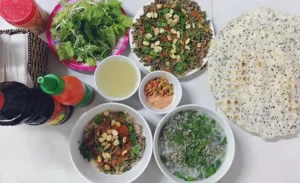 Visitors to Gio Linh commune should try the clam vermicelli soup. The clam must be soaked overnight in rice water to release all the sand and slime, then washed off the mud on the outside, then boiled and cleaned to remove the intestines. The boiled water is left to settle and used as broth.
Visitors to Gio Linh commune should try the clam vermicelli soup. The clam must be soaked overnight in rice water to release all the sand and slime, then washed off the mud on the outside, then boiled and cleaned to remove the intestines. The boiled water is left to settle and used as broth.
Fry the onion and fat, then add the clam and stir-fry with a little seasoning to make the meat firm and flavorful. Served with vermicelli and fish sauce with garlic and ginger.
Bombay duck fish hotpot
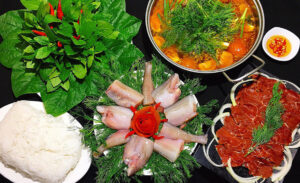 This specialty dish is also called fish porridge, sold at many restaurants in Dong Hoi. The bombay duck fish has a soft, round body, cartilage bones, no scales, white, soft meat. To make the hotpot broth more delicious and sweet, some chefs simmer pork or chicken bones first and then add a mixture of sour star fruit, sour bamboo shoots, tomatoes, tamarind juice, mushrooms, etc. The last step is to season the broth so that it has a sour taste, mixed with a bit of natural sweetness and spiciness.
This specialty dish is also called fish porridge, sold at many restaurants in Dong Hoi. The bombay duck fish has a soft, round body, cartilage bones, no scales, white, soft meat. To make the hotpot broth more delicious and sweet, some chefs simmer pork or chicken bones first and then add a mixture of sour star fruit, sour bamboo shoots, tomatoes, tamarind juice, mushrooms, etc. The last step is to season the broth so that it has a sour taste, mixed with a bit of natural sweetness and spiciness.
This specialty dish has a rich flavor that blends the sweetness of the fish with the hot sourness and spiciness of the broth, making everyone exclaim.
Buffalo meat with trong leaves
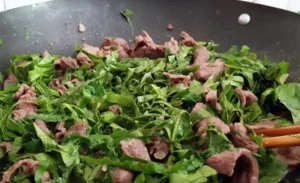 Buffalo meat can be processed into many dishes, but when cooked with trong, the local leaves, it will give a strange flavor. Fresh buffalo meat is cut into bite-sized pieces, marinated with spices and grilled with leaves of the trong. The meat is grilled evenly, the inside is soft and cooked, the outside is brown, the meat is firm. The meat is served on a plate with some vegetables.
Buffalo meat can be processed into many dishes, but when cooked with trong, the local leaves, it will give a strange flavor. Fresh buffalo meat is cut into bite-sized pieces, marinated with spices and grilled with leaves of the trong. The meat is grilled evenly, the inside is soft and cooked, the outside is brown, the meat is firm. The meat is served on a plate with some vegetables.
In addition to being grilled, buffalo meat is often stir-fried with this type of leaf and thinly sliced garlic and onions. The dish has a mild, spicy taste, the buffalo meat is sweet.
Sea snake
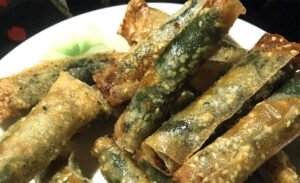
Den a type of sea snake, its meat is very delicious so it is the main ingredient to prepare many delicious dishes: sea snake porridge, sea snake hotpot, grilled sea snake, sea snake stir-fried with lemongrass and chili… among which, sea snake spring rolls and sea snake wine attract the most tourists.
To make a sea snake spring rolls, the snake is cleaned, chopped finely and mixed with spices such as lemongrass, betel leaves and a few other ingredients according to local taste to create the unique dish. If you want to enjoy this dishes, a series of restaurants on the Nhat Le coast are the ideal choice.
Seafood
Seafood in Quang Tri is very rich and reasonably priced, with unique ways of processing such as bombay duck fish hotpot, fish salad, steamed crab… Fish salad is usually grouper or white sardine fish. Fish is dipped in lime juice, rolled in rice paper with various ingredients. Fish salad is sold in many seafood restaurants in the center of Dong Hoi ward, and restaurants on boats on Nhat Le river.
Source: collected by An
Follow us for the best deal with Vietnam package tours and visa services!
